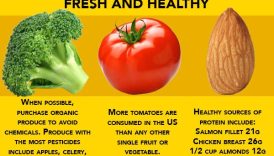A Beginner’s Guide to Nourishing Your Body with Living Foods

Introduction to Living Foods
What Are Living Foods?
Living foods, in essence, are those that come to life through nature’s processes and have not been significantly altered or processed. This category primarily includes raw fruits, vegetables, nuts, seeds, and sprouted grains. Unlike conventional foods that might have gone through cooking or chemical treatments, living foods retain their natural enzymes, vitamins, and minerals. For instance, when you eat a fresh apple straight from the tree or enjoy a salad made with raw spinach and tomatoes, you are consuming living foods. These vibrant, nutrient-rich options are believed to elevate one’s health by providing an abundance of naturally occurring nutrients.
- A Beginner’s Guide to Nourishing Your Body with Living Foods
- Introduction to Living Foods
- What Are Living Foods?
- Benefits of Consuming Living Foods
- Understanding Enzymes in Living Foods
- Role of Enzymes in Digestion
- Sources of Enzymes in Living Foods
- Incorporating Organic Foods Into Your Diet
- Importance of Organic Living Foods
- How to Identify and Select Organic Produce
- Exploring Fermented Foods
- Health Benefits of Fermented Living Foods
- How to Make Fermented Foods at Home
- Boosting Gut Health with Probiotics
- Importance of Probiotics for Digestive Health
- Probiotic-Rich Living Foods to Add to Your Diet
Benefits of Consuming Living Foods
The benefits of incorporating living foods into your diet are impressive and multifaceted. Many people personally report increased energy levels and improved digestive health after switching to a diet rich in these nutrient-dense options. Here are some notable advantages:
- Enhanced Nutrient Intake: Living foods are packed with essential vitamins, minerals, and phytonutrients that contribute to overall health.
- Improved Digestion: The enzymes present in raw foods can help break down food more efficiently, promoting a healthy digestive system.
- Boosted Energy Levels: Natural energy from living foods can lead to greater alertness and vitality throughout the day.
- Weight Management: Low in calories yet high in fiber, living foods can help control hunger and support weight loss efforts.
- Skin Health: The abundance of antioxidants found in these foods contributes to clearer and healthier skin.
By making incremental changes towards a living foods diet, individuals can experience not just physical health benefits but also improvements in mood and mental well-being. Consider swapping out conventional snacks for a handful of raw nuts or nibbling on fresh veggies during breaks. These small adjustments can lead to a more vibrant, nourished life.
Understanding Enzymes in Living Foods
Role of Enzymes in Digestion
As we delve deeper into the world of living foods, it’s essential to highlight the critical role that enzymes play in digestion. Enzymes are special proteins that act as catalysts in our bodies, speeding up biochemical reactions and making it easier for us to break down and absorb the nutrients from our food. When consuming living foods, these enzymes support your digestive system in several key ways:
- Breakdown of Nutrients: Enzymes help decompose macronutrients—carbohydrates, proteins, and fats—into smaller, more digestible parts. For example, amylase, an enzyme found in saliva, initiates the breakdown of starches as soon as you take a bite of your food.
- Improved Nutrient Absorption: By breaking down food into simpler forms, enzymes enhance the absorption of vital nutrients in the small intestine, ensuring our bodies get everything they need to function optimally.
- Reduced Digestive Strain: With living foods already rich in natural enzymes, your body doesn’t have to work as hard to digest them, potentially leading to less bloating and discomfort.
During her switch to a living foods diet, Jane found that her chronic bloating vastly improved. Instead of feeling heavy after meals, she noticed a significant reduction in discomfort, which she attributed to the digestive efficiency provided by the natural enzymes present in her food.
Sources of Enzymes in Living Foods
Now that we understand the pivotal role of enzymes in digestion, let’s explore where these enzymes can be found in living foods. Some common sources include:
- Fruits: Pineapples (bromelain) and papayas (papain) are rich in digestive enzymes.
- Vegetables: Leafy greens like spinach and kale, as well as cruciferous vegetables like broccoli and cabbage, contain various enzymes that aid digestion.
- Nuts and Seeds: Raw nuts, such as almonds, and seeds like sunflower seeds are great sources of enzymes. Soaking them before consumption can significantly increase their enzyme content.
- Sprouted Grains: Sprouting grains, such as quinoa or brown rice, activates enzymes that aid digestion and nutrient absorption.
Incorporating these enzyme-rich living foods into meals can help create a healthier, more efficient digestive system, which is fundamental for maintaining overall well-being. By prioritizing fresh, raw options, individuals can optimize their health while enjoying a diverse and delicious diet.
Incorporating Organic Foods Into Your Diet
Importance of Organic Living Foods
Transitioning into a diet rich in organic living foods is a step towards not only personal health but also a healthier planet. Organic foods are cultivated without the use of synthetic pesticides, fertilizers, or genetically modified organisms (GMOs). This means they often retain more nutrients and have superior flavors, which can significantly enhance meals. Many individuals, like Tom, an avid gardener, have noticed the differences firsthand. Tom began his journey with organic foods by growing his own vegetables and quickly realized that the taste was unparalleled compared to store-bought options. Here are some key reasons why organic living foods are worth considering:
- Healthier Nutritional Profile: Studies suggest that organic fruits and vegetables may contain higher levels of antioxidants and essential nutrients.
- Reduced Chemical Exposure: Choosing organic reduces the amount of harmful chemicals and residues that enter your body.
- Environmental Impact: Organic farming promotes biodiversity and helps protect water quality, making it a more sustainable choice for the environment.
- Animal Welfare: Organic animal products come from livestock raised in humane conditions without antibiotics and growth hormones.
By embracing organic living foods, individuals can contribute to better health outcomes and a more sustainable world.
How to Identify and Select Organic Produce
Navigating the world of organic produce can seem daunting at first, but with a few tips, anyone can become proficient in selecting the best options. Here’s a simple guide to identifying and selecting organic produce:
- Look for Certification: In many countries, certified organic produce will have a seal from a regulatory body. In the United States, for example, the USDA Organic seal guarantees that the food meets organic standards.
- Check PLU Codes: If you’re shopping at a grocery store, look for the produce stickers with PLU codes. Organic items typically have a five-digit code starting with the number 9 (e.g., 94011 for organic bananas).
- Know Your Local Sources: Farmers’ markets are excellent places to find organic produce. You can often speak directly with the growers about their practices and the produce’s freshness.
- Seasonal Shopping: Buy organic. Seasonal fruits and vegetables are likely to be fresher, more flavorful, and more affordable.
By shopping mindfully and prioritizing organic living foods, individuals can make informed decisions that benefit both their health and the planet. Incorporating these strategies can transform your kitchen into a plentiful space filled with vibrant, nourishing foods.
Exploring Fermented Foods
Health Benefits of Fermented Living Foods
As we dive into the realm of fermented foods, it’s crucial to acknowledge their significance in a healthy diet. Fermented living foods contain beneficial probiotics—live bacteria that provide numerous health benefits. Many people have experienced transformations in their health after incorporating these foods into their daily regimen. Take Laura, for example, a friend who struggled with digestive discomfort for years. Once she started adding fermented foods like kimchi and yogurt to her meals, she noticed an incredible difference in her gut health. The benefits of consuming fermented foods include:
- Improved Digestive Health: The probiotics in fermented foods can help balance gut flora, enhancing digestion and reducing bloating.
- Boosted Immunity: A healthy gut contributes to a stronger immune system, helping your body fight off infections and illnesses.
- Enhanced Nutrient Absorption: Fermentation can increase the bioavailability of nutrients, making it easier for your body to absorb vitamins and minerals.
- Mental Well-being: There is a growing body of research linking gut health to mental health, suggesting that consuming probiotic-rich foods may support mood and cognitive function.
Incorporating fermented living foods into your diet could be a game-changer for overall health and wellness.
How to Make Fermented Foods at Home
If you’re ready to step into the world of creating your own fermented foods, the good news is that it’s simpler than it sounds. Fermenting at home allows for creativity and ensures you know exactly what’s in your food. Here’s how to get started:
- Choose Your Ingredients: Common choices for beginners include vegetables (like cabbage for sauerkraut), dairy (like yogurt), or beverages (like water kefir).
- Prepare Your Produce: For example, if making sauerkraut, shred the cabbage and mix it with salt, which creates an environment conducive to fermentation.
- Pack in a Jar: Place the prepared ingredients in a clean glass jar, pressing them down to eliminate air gaps. Leave some space at the top, as gases will form during fermentation.
- Cover and Let Ferment: Use a breathable cloth or a fermentation lid to cover the jar. Store in a cool, dark place and allow the mixture to ferment for a few days to weeks, depending on the desired flavor.
- Taste Test: Periodically taste your ferment to see if it has reached your preferred level of tanginess. Once ready, seal the jar tightly and store it in the fridge.
By making fermented foods at home, individuals can not only enjoy delicious and healthful additions to their diets but also expand their culinary horizons. The process encourages creativity in the kitchen while delivering a powerhouse of probiotics to support gut health.
Boosting Gut Health with Probiotics
Importance of Probiotics for Digestive Health
Now that we’ve explored the wonders of fermented foods, it’s time to highlight the critical role of probiotics in enhancing gut health. Probiotics are live microorganisms, primarily bacteria and yeasts, that can provide numerous health benefits, particularly in digestion. Take Mark, who faced recurring digestive issues due to stress and dietary habits. After integrating probiotics into his daily routine, he found his gut health dramatically improved, and his discomfort diminished. Here’s why probiotics are so vital for digestive health:
- Restoring Balance: Probiotics help maintain a healthy balance of gut microorganisms. When this balance is disrupted due to factors like antibiotic use or poor diet, probiotics can help restore it.
- Enhancing Digestion: Probiotics break down food more efficiently, reducing the workload on the digestive system, and leading to improved nutrient absorption.
- Reducing Inflammation: Many probiotics have anti-inflammatory properties, which can help alleviate conditions like Irritable Bowel Syndrome (IBS) and other inflammatory bowel diseases.
- Boosting Immunity: A healthy gut contributes to a stronger immune system, as a significant portion of immune function is dependent on gut health.
Including probiotics in daily life can be game-changing for anyone looking to improve their overall digestive wellness.
Probiotic-Rich Living Foods to Add to Your Diet
There are plenty of delicious ways to ensure you’re getting enough probiotics. Here’s a list of probiotic-rich living foods that can easily fit into your meals:
- Yogurt: Look for live-cultured yogurt, as it contains beneficial strains of bacteria like Lactobacillus and Bifidobacterium.
- Kefir: This fermented milk drink is packed with probiotics and can be consumed on its own or added to smoothies.
- Sauerkraut: Fermented cabbage not only provides probiotics but is also rich in vitamins, particularly vitamin C.
- Kimchi: A spicy Korean side dish made from fermented vegetables (typically napa cabbage) that offers a unique flavor along with probiotics.
- Miso: This fermented soybean paste, often used in soups, is rich in probiotics and adds depth of flavor to various dishes.
- Tempeh: A fermented soybean product that is not only a great source of protein but also offers probiotic benefits.
By incorporating these probiotic-rich living foods into your diet, individuals can enjoy a diverse range of flavors while significantly supporting their digestive health. Remember, each person’s gut is unique, so experimenting with different sources can help you discover what works best for your body. Whether you add yogurt to breakfast or include kimchi in your lunch, the journey toward better gut health can be both enjoyable and fulfilling.





